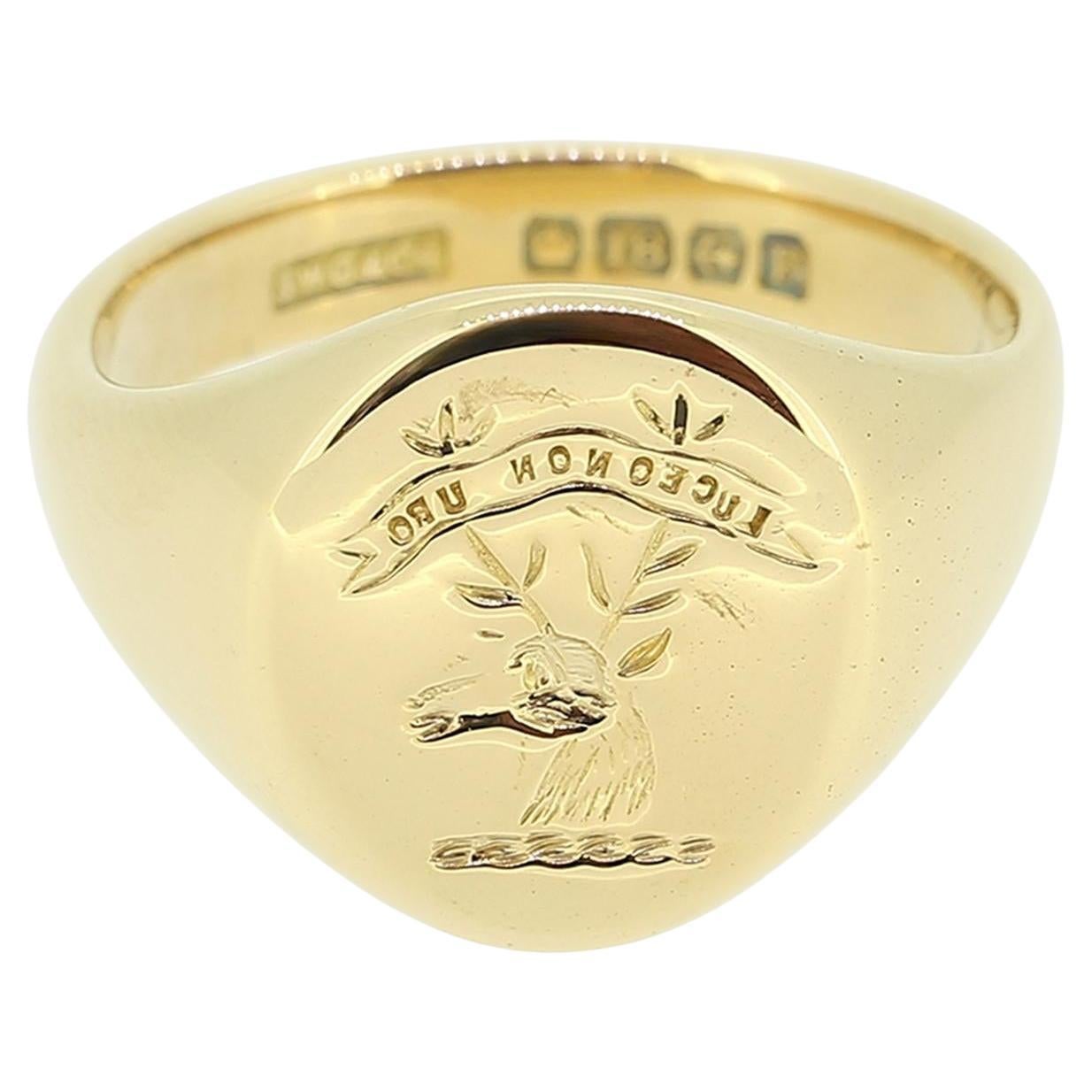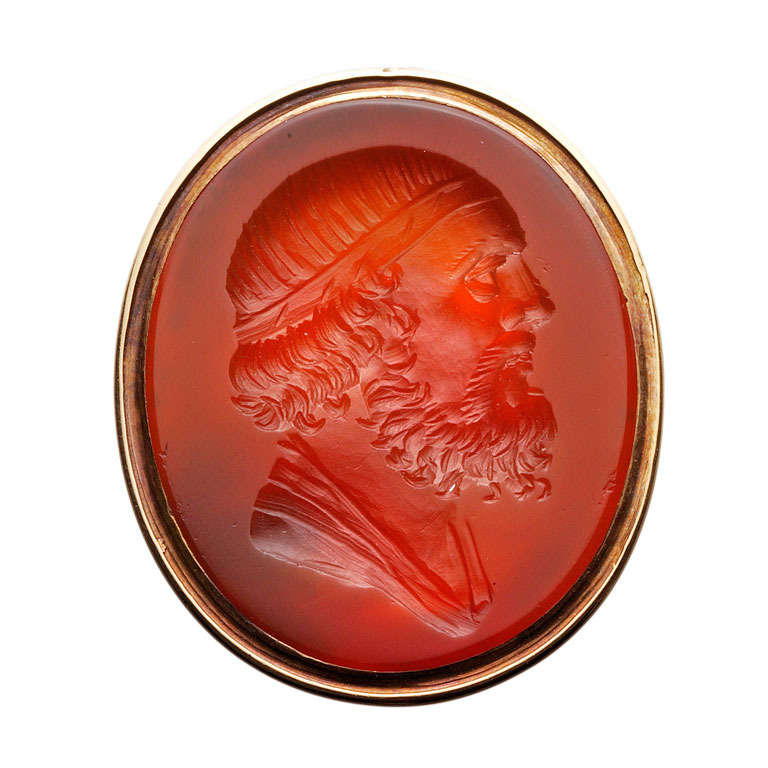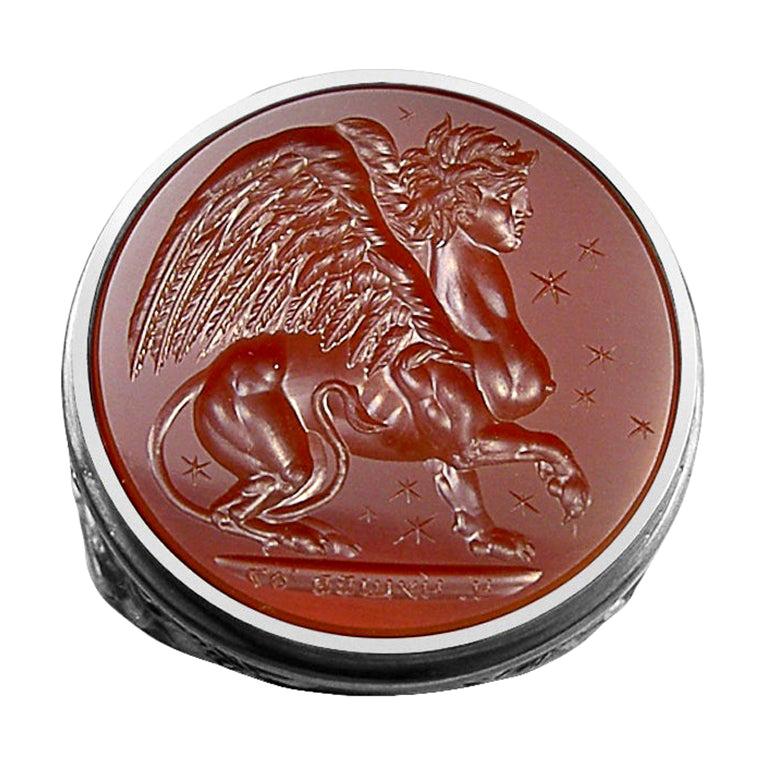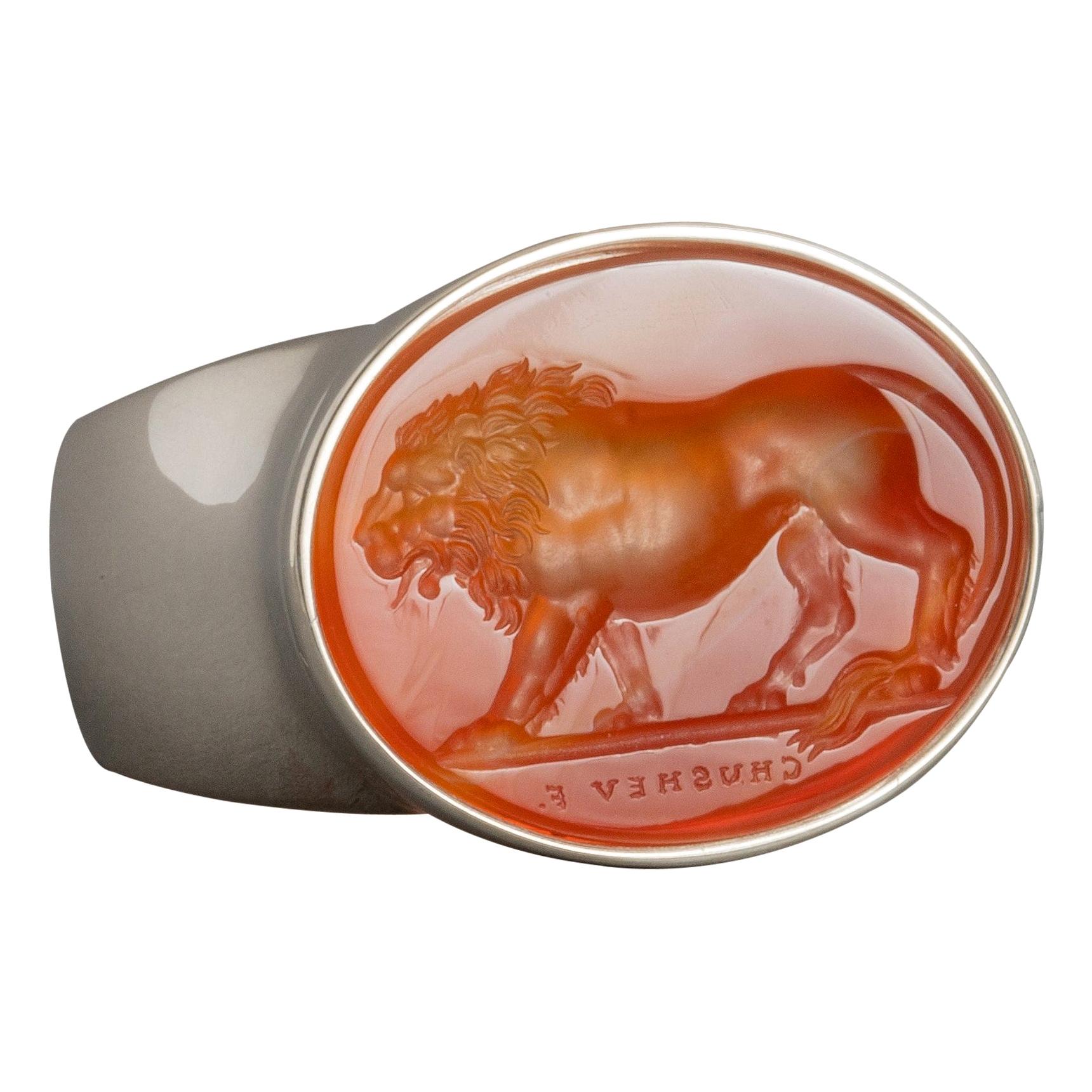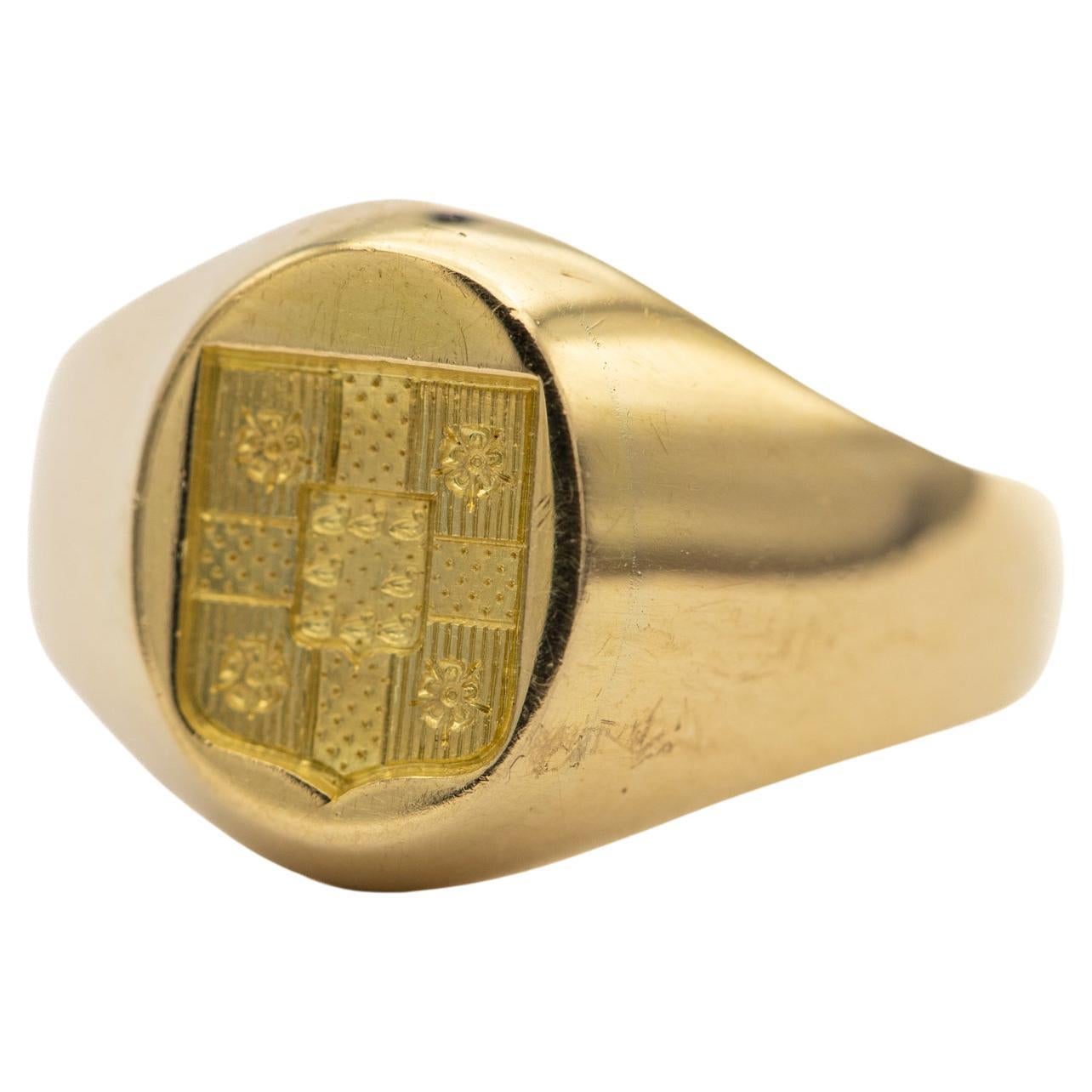Items Similar to French Neo-Renaissance Intaglio Signet Ring Manner of Wièse & Froment-Meurice
Video Loading
Want more images or videos?
Request additional images or videos from the seller
1 of 19
French Neo-Renaissance Intaglio Signet Ring Manner of Wièse & Froment-Meurice
About the Item
A fantastic French 19th century Neorenaissance silver intaglio ring, in the manner of Jules Wièse and Froment-Meurice, circa 1840. The milky blue chalcedony intaglio is engraved to depict a French heraldic family coat of arms with two roses and a lion. This particular coat of arms is adopted by a number of French noble families, namely the Begon and Joisel families, as well as the Oudan family of Champagne (message for photo for examples).
The bezel set intaglio is surrounded on each side by an intricately worked silver greyhound, a widely used motif in heraldry as well as in the decorative arts to symbolise wealth and the chivalric virtues of faithfulness and loyalty.
UK ring size N , US size 7
7.94g, intaglio measures 11mm x 9mm
A highly skilled chiseller and jeweller from Germany, Jules Wièse (1818-1890) worked in Paris and collaborated closely with the famous goldsmith and jeweller François-Désiré Froment-Meurice (1802-1855) throughout the mid-19th century. In 1855, he directed the execution of the reliquary of the Talisman of Charlemagne for Emperor Napoleon III, and in 1860, the sword of Marshal de Mac-Mahon. The two pioneered the neo-gothic and neo-renaissance styles and made many pieces of jewellery stylistically similar to this ring. A similar example from the Wièse and Froment-Meurice workshop can be found in the British Museum Collection (item AF.2558), message for reference photos.
The ring is stamped on the outside band with an antique French control mark, although it’s somewhat faded, it appears a silver ‘mask’ stamp which indicates that it was made in Paris between 1819-1838 which matches with the style of the ring. The inner band has also been stamped with later English marks from when it would have been brought over and/or sold again locally at a later date, hence the need for an English hallmark to be placed.
- Ring Size:7 US, Not Resizable
- Metal:
- Stone:
- Stone Cut:
- Weight:7.94 g
- Style:
- Place of Origin:
- Period:
- Date of Manufacture:1855
- Condition:
- Seller Location:London, GB
- Reference Number:1stDibs: LU2845218806222
About the Seller
5.0
Vetted Seller
These experienced sellers undergo a comprehensive evaluation by our team of in-house experts.
Established in 2019
1stDibs seller since 2022
32 sales on 1stDibs
Typical response time: 14 hours
- ShippingRetrieving quote...Ships From: London, United Kingdom
- Return PolicyA return for this item may be initiated within 14 days of delivery.
More From This SellerView All
- Important Antique Finnish 18K Coat of Arms Klinckowström Intaglio Signet RingLocated in London, GBA superb, scarce Finnish antique 18K gold ring that was made in Helsinki in the year 1854. The oval carnelian coat of arms intaglio is set in a large intricate gold repoussé work mount featuring scrolled foliate motifs. Incredibly, thanks to a full set of Finnish hallmarks, as well as from the intaglio carving itself, we can identify who commissioned and wore this superb seal ring. The coat of arms engraved into the carnelian gemstone is that of the Klinckowström family, an old Prussian noble house whose members played prominent roles in the history of Prussia, Sweden, Finland and Austria. The family was granted nobility in Sweden in 1684 by King Charles XI, and then received the rank of baron in 1759 from King Adolf Frederick. The baronial branch was listed in the Finnish House of Nobility (Ritarihuone) from 1818 until the family line ended in Finland in 1883. This baronial element can also be seen in the engraved coat of arms from the specific type of coronet used, it is set with pearls and known as a ‘Friherrlig rangkrona’, the coronet for Baron. The hallmarks tell us that this ring was made in Helsinki in the year 1854. Accordingly, the ring must have been made for a Baron (male) of the Klinckowström family, present and active in Finland during the mid-19th century. After researching into the genealogial records, only one member of the family settled in Finland, which was Baron Otto Wilhelm Klinkowström (1778-1850), and this ring would have been commissioned by his son Baron Arthur Wilhelm Wilhelmsson Klinckowström, shortly after his father’s passing. The ring would have been made in used to seal deeds and important letters in wax regarding family affairs. Arthur had two sons. Emil and Alexander who carried on the baronial title until 1883, when the family line ended on the male side. Although the time period of this ring also matches up with his both his sons, according to heraldry records they both carried a slightly different coat of arms. Arthur, the owner of this ring enrolled in the House of Knights in Finland aged 17 and soon after received the Order of St. John of Jerusalem. He spent the remainder of his years in various senior military positions, such as Lieutenant Colonel of the Finnish Sharpshooter Battalion and Colonel of the Kremenchugska Hunter Regiment. He passed away in 1860, not long after his father, which may explain why this ring is in such excellent condition with minimal signs of usage. His father, Baron Otto Wilhelm Klinkowström (1778-1850) was a Swedish lieutenant general who later moved to Finland, where he immediately found favour with Czar Alexander I of Russia...Category
Antique 1850s Finnish Victorian Signet Rings
Materials18k Gold
- Antique 17th Century Engraved Silver Heraldic Coat of Arms Intaglio Signet RingLocated in London, GBThis rare heraldic silver intaglio signet ring dates from the late 17th century and originates from Western Europe. The flat, octagonal bezel is engraved with a noble family coat of arms depicting an eight pointed star. The silver ring is cast in one piece, the intaglio is framed within a chased octagonal border and the band displays flared and chamfered edges at the shoulders, all features typical of the period. After looking into heraldry archives, there are a few families in Western Europe which share this coat of arms, notably the Ambrogini family of Italy and the Counts of Waldeck, vassals of Luxembourg since the 14th century (see Ravensbury Antiques...Category
Antique Late 17th Century European Stuart Signet Rings
MaterialsSilver
- Georgian 18th Century Signet Ring with Ancient Roman Nicolo Intaglio of HerculesLocated in London, GBA superb ancient Roman nicolo intaglio set in a late 18th century gold signet ring. Nicolo intaglios are a particular type of intaglio ma...Category
Antique Late 18th Century English Georgian Signet Rings
- Antique Gold Cameo Ring Greek Theatre Mask Silenus Hardstone Intaglio SignetLocated in London, GBA very unusual antique gold ring set with a carved brown and white hardstone cameo depicting the theatrical comic mask of Silenus, the Greek mythological old rustic god of wine-making and drunkenness. The ring was made in the late 19th century and carries French control marks for 18K gold, whilst the cameo is probably Italian and made slightly earlier, circa 1800. Silenus was a companion to the wine god Dionysus, and suitably he was a notorious consumer of wine, usually drunk and supported by satyrs or carried by a donkey. Silenus was described as the oldest, wisest and most drunken of the followers of Dionysus, and was said to possess special knowledge and the power of prophecy when intoxicated. He presides over the other satyrs and is related to musical creativity, prophetic ecstasy, drunken joy and drunken dances. Silenus was usually depicted as a jovial old man, bald yet bearded, with a pot-belly, thick lips and snub-nose. The masks worn to play him in theatre really emphasised these features, as you can see with this cameo carving Theatre was a key part of ancient Greek culture. The theatrical masks worn by the actors, known as ‘prosopon’, served various purposes. They enabled individual actors to play multiple roles (or genders) in the same performance; the exaggerated expressions helped define the character being portrayed; they helped spectators in the back rows to tell the characters apart. This particular masked as mentioned before is a comedic Silenus, please see final photo for other examples of Silenus masks in museum collections. UK size N 1/2, US size 7 4.84g 18K gold French ‘tête...Category
Antique Early 19th Century Italian Georgian Signet Rings
MaterialsAgate, 18k Gold
- Ancient Roman Green Chalcedony Plasma Intaglio Ring of Goddess Victoria NikeLocated in London, GBA scarce ancient Roman intaglio dating from the 1st to 2nd century AD, depicting Victoria, the Roman Goddess of Victory (also known as Nike in Greek mythology). The cabochon gemstone is a chromium chalcedony, mottled green in colour. It was known in the ancient world as a ‘plasma’ stone and was widely used in jewellery and seals throughout the Roman Empire. However the mineral disappeared from use in the ancient world towards the end of the 2nd century AD when the known deposits were mined out. The intricate ancient engraving depicts a winged Victoria, draped and facing left, holding a palm branch in her right hand and a laurel leaf in her left. The green gem is translucent and contains small dotted black natural inclusions. The gemstone’s viridian green tones were linked to nature, growth, and prosperity, reflecting the Romans' appreciation for abundance and fertility. Victoria played a major part of Roman society, with many temples erected in her honour including one on the Palatine Hill which would house the spoils of war from Roman victories. She was, to the Romans, a symbol of victory over death, ultimately determining who would be successful during war. The high number of artistic and architectural dedications to her bear witness to the popularity of the goddess’ cult: Victoria widely appears on Roman coins...Category
Antique 15th Century and Earlier Italian Classical Roman Signet Rings
MaterialsChalcedony, 22k Gold
- Antique Georgian Noble Irish 'Cole' Family Coat of Arms Signet Ring Earl's RingLocated in London, GBA large, heavy gold Irish noble signet ring, set with a carnelian intaglio depicting the coat of arms of the aristocratic Cole family. The stone would have originally been set into a...Category
Antique Early 19th Century English Georgian Signet Rings
MaterialsCarnelian, 14k Gold
You May Also Like
- Vintage Intaglio Signet RingLocated in London, GBHere we have an 18ct yellow gold oval shaped signet ring. This vintage piece showcases a finely detailed deep intaglio of the head of a stag. Above the main design the words read '...Category
Vintage 1930s Signet Rings
Materials18k Gold, Yellow Gold
- Georgian Carnelian Intaglio Gold Signet RingLocated in London, GBA Georgian carnelian intaglio ring, the oval cornelian measuring 21 x 18mm, seal-engraved with a classic male head, bearded and in profile, in a yellow gold setting with an open back...Category
Antique Early 19th Century British Georgian Signet Rings
MaterialsCarnelian, Yellow Gold
- Chushev Sphinx Carnelian Intaglio Sterling Silver Signet RingBy ChushevLocated in Canoga Park, CAThis exquisite intaglio is masterfully engraved onto a carnelian gemstone. The gem is set in a sterling silver gold ring. The shoulders of the ring are embellished with a classic "Gr...Category
2010s Classical Greek Signet Rings
MaterialsSterling Silver
- Chushev Demosthenes Carnelian Intaglio Sterling Silver Signet RingBy ChushevLocated in Canoga Park, CAThis exquisite intaglio is masterfully engraved onto rich carnelian gemstone and features the Ancient greek statesman and orator, Demosthenes The stone is set in an 925 sterling sil...Category
2010s Classical Greek Signet Rings
MaterialsCarnelian, Sterling Silver
- Chushev Lion Carnelian Intaglio Sterling Silver Signet RingBy ChushevLocated in Canoga Park, CAThis exquisite intaglio is masterfully engraved onto rich carnelian gemstone and features a majestic lion motif. The stone is set in an 925 sterling silver signet ring. Production time for this piece is up to 10 weeks Can be made in any size ranging from 8-12. Elaborately carved gems were a staple of luxury in antiquity and often incised onto semi-precious stones such as carnelian or jasper. In the form of a talisman they served as extraordinary symbols of status and in certain cases, they were believed to provide divine protection. They were also employed as a form of personal identification when pressed in hot wax or clay. Rulers, nobles and wealthy merchants sought, collected and traded these fascinating miniature works of art. Chavdar Chushev...Category
2010s Classical Greek Signet Rings
MaterialsCarnelian, Sterling Silver
- 18K French heavy signet ring - Intaglio ring - Patina solid gold gentleman ringLocated in Antwerp, BEFor sale is this wonderful large sized signet ring. This 18 K handmade oval stunner is a real sign of nobility and status which is perfect to wear with your favorite statement outfit...Category
Mid-20th Century French Napoleon III Signet Rings
MaterialsGold, 18k Gold, Yellow Gold
Recently Viewed
View AllMore Ways To Browse
Antique Ring Size N
French Style Antique Rings
Belle Epoque Antique Rings
Belle Epoque Rings
Antique Style Silver Rings
Antique Renaissance Jewelry
French Belle Epoque Ring
Antique Belle Epoque Ring
Neo Renaissance
French Neo Gothic
Antique Lion Jewelry
Bandes De Roses
Uk Jewellers
Gothic Photo
Renaissance Style Ring
Champagne Silver Ring
Antique Silver Sword
Antique Talisman
